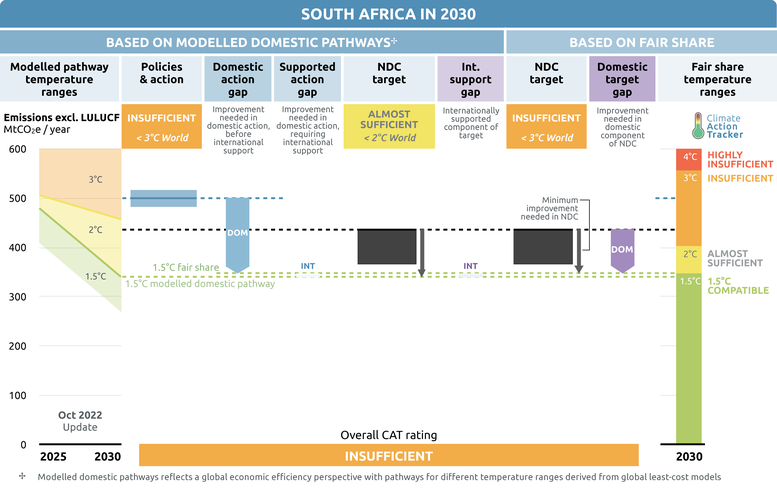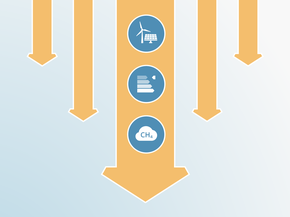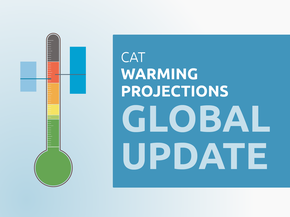Targets
Paris Agreement targets
In its updated NDC of 2021, South Africa commits to absolute emissions target levels in the range of 350–420 MtCO2e, including LULUCF, for 2030 (Government of South Africa, 2021c). Assuming LULUCF remains at the average level over 2007–2017 (-16 MtCO2e), this NDC target range translates to emission levels in 2030 of between 366–436 MtCO2e excluding LULUCF, equivalent to a 3–23% increase above 1990 levels excluding LULUCF.
The CAT rates South Africa's target as "Almost sufficient" when rated against modelled domestic pathways, and "Insufficient" when rated against the fair share contribution. South Africa does not specify a conditional target or an international element in its NDC, so we rate the unconditional target against the two rating frameworks.
The NDC document does not specifically mention whether the emissions range is an unconditional target, but the CAT interprets it as such. South Africa’s NDC assumes “that implementation and ambition will be enabled by finance and technology and capacity building support” (Government of South Africa, 2021c), similar to the previous, 2016, NDC. It also highlights that equality, economic and social development and poverty eradication are South Africa’s top priorities.
| South Africa — Main climate targets |
|---|
| 2030 unconditional NDC target | |||
|---|---|---|---|
| Formulation of target in NDC | In 2030, South Africa’s annual GHG emissions will be in a range from 350–420 MtCO2e | ||
|
Absolute emissions level in 2030 excl. LULUCF |
366–436 MtCO2e by 2030 excluding LULUCF (uncertainty on GWP used) [3–23% above 1990 by 2030 excl. LULUCF] [18%–31% below 2010 by 2030 excl. LULUCF] |
||
| Status | Submitted on 27 September 2021 | ||
| Net zero & other long-term targets | |||
|---|---|---|---|
| Formulation of target | "We thus commit to ultimately moving towards a goal of net zero carbon emissions by 2050, which will require various interventions to reduce greenhouse gas emissions." | ||
|
Absolute emissions level in 2050 excl. LULUCF |
Not available as net zero target by 2050 only announced as a visionary statement | ||
| Status | Submitted on 23 September 2020 | ||
NDC updates
South Africa submitted a submitted a stronger target on 27 September 2021.
The updated NDC strengthened the country’s target range for 2030: the upper end is now 31% lower and the lower end 12% lower than in the previous, 2016, NDC.
The government followed the recommendations of the South African Presidential Climate Commission from June 2021. The multi-stakeholder group established by President Ramaphosa provided advice on the country’s NDC update, proposing stronger 2030 targets, going beyond a first draft NDC published for public consultation in March 2021.
While the updated 2021 NDC increased South Africa’s climate ambition towards 2030 and increased clarity, transparency and understanding, the target range is not yet in line with the 1.5˚C temperature goal.
The 2021 NDC no longer makes reference to a peak-plateau-decline (PPD) trajectory, which foresaw South Africa’s emissions plateauing for approximately a decade between 2025 and 2035 and then declining in absolute terms towards 2050 (Government of South Africa, 2016).
| SOUTH AFRICA — History of NDC updates | First NDC | 2021 NDC update |
|---|---|---|
| 1.5°C compatible |
|
|
| Stronger target | N/A |
|
| Economy-wide coverage |
|
|
| Fixed/absolute target |
|
|
| South Africa | First NDC | 2021 update |
|---|---|---|
| Formulation of target in NDC | South Africa's emissions by 2025 and 2030 will be in a range between 398 and 614 MtCO2e | In 2030, South Africa’s annual GHG emissions will be in a range from 350–420 MtCO2e* |
|
Absolute emissions level excl. LULUCF |
Emissions excl. LULUCF of 414–630 MtCO2e over 2026–2030 (using AR4 GWP) |
Emissions excl. LULUCF of 366–436 MtCO2e over 2026–2030 (uncertainty on GWP used) [Upper limit is 31% lower than 2016 NDC if same GWP used for target range as in NDC of 2016] |
|
Emissions compared to 1990 and 2010 excl. LULUCF |
17–78% above 1990 levels 22% below to 19% above 2010 levels |
3–23% above 1990 levels 18–31% below 2010 levels |
| CAT rating |
Overall rating**: Highly insufficient |
NDC target against modelled domestic pathways: Almost sufficient NDC target against fair share: Insufficient |
| Sector coverage | Economy-wide | Economy-wide |
| Separate target for LULUCF | No | No |
| Gas coverage | Coverage of all six gases with focus on CO2, CH4, and N2O (reporting on SF6 remains work in progress) |
CO2, CH4, N2O, HFCs and PFCs (SF6 and NF3 not included) |
| Target type | Absolute emissions reduction (trajectory target/multiple years) | Absolute emissions reduction (trajectory target/multiple years) |
| Explanation why the target is a fair contribution towards the global goal | Yes, holistic explanation provided in light of national circumstances, and priorities to eliminate poverty and inequality, promote inclusive economic growth and reduce unemployment | Yes, holistic explanation provided in the light of its national circumstances referring to its status as a developing county, national circumstances and common but differentiated responsibility and respective capability, and the Paris Agreement’s long-term temperature goal |
| Followed guidance in Decision 4/CMA.1 on target transparency | Not applicable | Yes, although remaining uncertainty on GWP used for target range in NDC of 2021 |
* Please refer to the ‘Assumptions’ section for more details on the CAT’s assumptions on GWP used by South Africa.
** Before September 2021, all CAT ratings were based exclusively on fair share.
Target development timeline & previous CAT analysis
- 27.09.2021 – South Africa’s updated NDC increases its climate ambition and transparency, although not yet sufficient to be in line with Paris Agreement temperature goal
- 16.07.2021 – South Africa's Presidential climate commission recommends stronger mitigation target range for updated NDC: close to 1.5°C compatible
- 30.03.2021 – South Africa’s updated NDC draft increases its climate ambition and transparency, although very likely not yet sufficient to be in line Paris Agreement temperature goal
CAT rating of targets
We rate the proposed 2030 NDC target levels as “Almost sufficient” when compared to modelled emissions pathways. The “Almost sufficient” rating indicates that South Africa’s NDC target in 2030 is not yet consistent with limiting warming to 1.5°C but could be with moderate improvements. If all countries were to follow South Africa’s approach, warming could be held at—but not well below—2°C.
South Africa currently relies on foreign investments and international finance support to implement a large percentage of its climate change programmes, and the government also emphasises in its updated NDC that the implementation of its NDC will be enabled by financial support as specified in the Paris Agreement.
The starting year for the modelled domestic pathways is 2015. The modelled domestic emissions pathways are based on regional scenarios and emissions in South Africa, as opposed to the region on average, are already stabilising. Because of this, the modelled domestic pathways deviate from the historical data and are higher in 2020.
We rate South Africa’s 2030 NDC target as “Insufficient” when compared with its fair share contribution to climate action. The “Insufficient” rating indicates that South Africa's NDC target in 2030 need substantial improvements to be consistent with limiting warming to 1.5°C. If all countries were to follow South Africa’s approach, warming would reach over 2°C and up to 3°C.
CAT interprets the full NDC target as unconditional. As South Africa only needs to reach its upper end of the target range to fulfil the NDC, we rate that emissions level. If South Africa committed to meeting the lower end of its target range, the rating would change to “Almost sufficient”, but close to the border to “1.5°C compatible”, when compared to modelled domestic pathways, and to “Almost sufficient” when compared to the fair share contribution.
Further information on how the CAT rates countries (against modelled pathways and fair share) can be found here.
Net zero and other long-term target(s)
The updated NDC of 2021 no longer refers to a peak-plateau-decline (PPD) trajectory. The previous peak-plateau-decline (PPD) trajectory, outlined in South Africa’s South Africa’s Copenhagen Accord pledge, foresaw South Africa reducing GHG emissions to 212–428 MtCO2e by 2050 including LULUCF (Department of Environmental Affairs, 2018; Government of South Africa, 2010).
South Africa’s Long-Term Strategy submitted to the UNFCCC in October 2020 still refers to this PPD trajectory as a benchmark “in the absence of an agreed quantitative articulation of the vision” (Republic of South Africa, 2020).
The CAT no longer considers the previous 2050 target range an official long-term target for South Africa given it is no longer mentioned in the updated NDC of 2021 and merely used as a benchmark in the LTS of 2020.
South Africa first stated its intention to commit to a net zero CO2 target (“net zero carbon emissions”) by 2050 as part of a visionary statement in its LTS (Republic of South Africa, 2020). In this context, the National Planning Commission is in the process of developing a common vision for South Africa in 2050 and will subsequently update its Low-Emission Development Strategy. The Just Transition Framework, released by the Presidential Climate Commission in June 2022 and approved by the Cabinet in September 2022, refers to reaching “net-zero greenhouse gas emissions by 2050” (Government of South Africa, 2022b; Presidential Climate Commission, 2022).
Given its preliminary nature, and the lack of more detailed information, the CAT currently does not evaluate South Africa’s net zero target. The CAT will do so once further information is communicated by the government.
Further analysis
Latest publications
Stay informed
Subscribe to our newsletter





